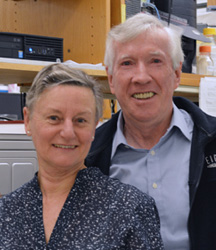Bringing Light to the ‘Dark’ Side of Biology: An Interview with Peter Wright and Jane Dyson
In the 1990s, Professors Peter Wright and Jane Dyson at The Scripps Research Institute (TSRI) noticed an odd protein. While many proteins are well structured—like crisp origami creations—this new protein, while functional, seemed just to flop around.
Since then, research has indicated that about a third of the human proteome, the proteins our genes encode, is made up of these “intrinsically disordered proteins,” or IDPs.
Now Wright and Dyson have come together with researchers across the country to start the Human Dark Proteome Initiative, which was announced November 9 following a regional meeting of the American Chemical Society. In an interview with News&Views, the duo explained why IDPs are important and how they could hold the key for treating many diseases.
Why call it the “dark” proteome?
WRIGHT: This proteome is the “dark matter” of biology—we know comparatively little about it. Back in the 1990s, the dogma was that all proteins function through their 3D structures, but we had three or four examples in the lab of proteins were that were not structured but were fully functional. When we came upon the first of these, I said to the postdoc (Richard Kriwacki), who showed me the data, “You’ve messed up the purification; go back and do it again.” We did that three times until finally we collaborated with Steven Reed’s lab at TSRI to show that this unstructured protein was fully functional.
DYSON: It wasn’t folded, yet it was functional. Some of the IDPs never fold up. You could call them fluid or gel-like.
WRIGHT: Disordered proteins do not have a single shape but fluctuate over many different structures. This is actually important because then they can adopt different structures when they bind with different partners. When they bind to an enzyme, they may have one structure, and when they bind to a signaling target, they can adopt an entirely different structure. IDPs are essentially the wiring of the cellular signaling machinery.
DYSON: IDPs do many things. For example, some IDPs can make non-membrane-bound organelles in the cell and they keep things in homeostasis.
How are these proteins important for human health?
WRIGHT: Given the role disordered proteins play in controlling cell signaling, it’s not surprising that things can go wrong. IDPs are involved in heart disease, infectious disease, type 2 diabetes and many neurodegerative diseases, such as Alzheimer’s. Cancer is a big one—about 60 to 70 percent of the proteins associated with cancer are entirely disordered or have large disordered regions.
DYSON: This is why the dark proteome initiative is important. This could be a big area for therapeutics.
What kinds of therapeutics are you picturing?
WRIGHT: There are many potential therapeutic strategies. For example, you could specifically target what goes wrong in cancer. Hypoxia is one of the big problems in cancer growth. If you can shut down the hypoxic response, you can starve a growing tumor. And the hypoxic response is based around disordered proteins. Targeting the interactions of these disordered proteins is a way of inhibiting the hypoxic response to halt angiogenesis and vascular growth that feeds the tumor.
How will the Human Dark Proteome Initiative help?
WRIGHT: The point of the Human Dark Proteome Initiative is to try to bring more attention to the field, to show how deeply the dark proteome penetrates biology and what the potential is for future therapeutics. We’d like to advocate launching centers of excellence, where resources would be put toward studying the dark proteome and the interactions of these proteins.
DYSON: We’d really like to see how these little molecular machines do their work.
This field seems like a whole different dimension for how to look at biology.
DYSON: It’s a way of thinking about how proteins can work, and it took us a long time to get our heads around it.
WRIGHT: There’s absolutely no question that if it weren’t for the support of the Skaggs family foundation, The ALSAM Foundation, early on, we could not have made progress in studying IDPs. Disordered proteins sounded like heresy back then. It was really the Skaggs’ support that got us off the ground and helped establish the field.
Why is TSRI a good home for IDP studies?
WRIGHT: TSRI is one of the leading institutions for studying disordered proteins. We have an awareness of the importance of disordered proteins in disease and we have the right technology.
DYSON: TSRI has a powerful NMR (nuclear magnetic resonance) facility. NMR is great because it allows you to look at the motions of the molecules and obtain information even when the molecules are not folded.
WRIGHT: Other researchers, such as TSRI Associate Professor Ashok Deniz, also work on disordered proteins. Ashok has worked for a long time on the disordered protein that leads to Parkinson’s disease and has done a lot to characterize it.
DYSON: Ashok is using single-molecule biophysics and a technique called fluorescence resonance energy transfer (FRET) to study IDPs, but you could also use the cryo-EM facilities at TSRI to get a picture of the whole protein in multiple states, and you could use NMR to see it in motion.
WRIGHT: This is the challenge of the dark proteome: no one technique is going to solve these problems. You’re dealing with proteins that are either completely disordered or have both folded, structured regions and disordered regions.
DYSON: In fact, you could call it a can of worms!
Send comments to: press[at]scripps.edu














